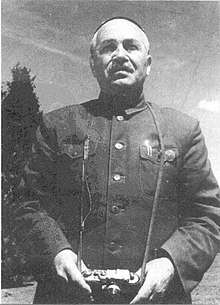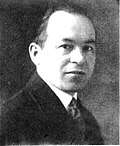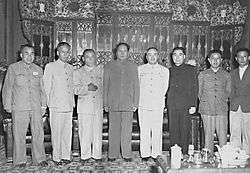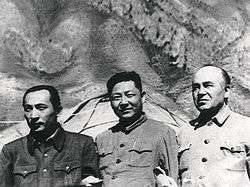Burhan Shahidi
Burhan Shahidi (Uyghur: بۇرھان شەھىدى, برهان شهيدي, ULY: Burhan Shehidi ; simplified Chinese: 包尔汉·沙希迪; traditional Chinese: 包爾漢·沙希迪; pinyin: Bāo'érhàn·Shāxīdí; Russian: Бурхан Шахиди; Tatar: Borhan Şähidi; also spelled Bao Erhan; October 3, 1894 – August 27, 1989) was a political leader in Xinjiang, China during the 20th century.
Burhan Shahidi | |
|---|---|
 Burhan Shahidi in 1950 as Chairman of Xinjiang Province | |
| Governor of Xinjiang | |
| In office 1949–1949 | |
| Preceded by | Masud Sabri |
| Succeeded by | Yulbars Khan |
| Personal details | |
| Born | Burhan October 3, 1894 Kazan Governorate, Russian Empire |
| Died | August 27, 1989 (aged 94) Xinjiang, China |
| Nationality | Tatar |
| Political party | CC Clique of Kuomintang party |
| Military service | |
| Allegiance | |
Life
Early life
Burhan Shahidi was born in 1894 in the Russian Kazan Governorate to a family whose ancestors had fled from Aksu, an oasis town in Southern Xinjiang, after a failed peasant uprising during the Qing dynasty.[1] His family was poor and he received little schooling in his early years. In 1912, after the Qing Dynasty was overthrown, he accompanied Tatar merchants to Dihua (now Ürümqi) in Xinjiang and worked as an apprentice and store-clerk.[2] In 1914, he was able to apply and receive Chinese citizenship from the Republic of China on account of his family's ancestry.[1] He spoke Uyghur, Mandarin Chinese, Russian, Turkish and some Arabic and acted as the interpreter for Yang Zengxin, the leader of Xinjiang at the time[2] Jadid leader Ismail Gasprinski inspired Burhan Shahidi.[3]

In 1929, he was sent to Weimar Germany by Xinjiang's next leader Jin Shuren and studied political-economy in Berlin. He returned to Xinjiang in 1933 and held a number of roles in the provincial government including manager of a land development company.[4] He played a key role in the Xinjiang Nationalities Congress of 1934. At this Congress, the ethnonym Uyghur was adopted to describe the majority Turkic Muslims in the oases of the Tarim Basin.[5]
Republic of China

In 1937, he was dispatched by the next governor, Sheng Shicai, to the Soviet Union to serve as a consular official in the border district of Zaysan.[4] The following year, he was recalled by Sheng, branded a "trotskyite" and imprisoned until 1944.[1] While in prison, Burhan wrote a Uyghur-Chinese-Russian Dictionary and translated Sun Yat-sen's Three People's Principles into Uyghur.
He was released by Wu Zhongxin, the Chinese Nationalist official who replaced Sheng Shicai. In 1946, Burhan became the vice-chairman of a provincial coalition government formed between the Chinese Nationalists and the revolutionaries who had founded the Second East Turkestan Republic (Second ETR) in the "Three Districts".[6] He was considered a political moderate between the Nationalist Chinese and Second ETR members of the coalition.[7]
In 1947, Burhan was transferred to Nanjing and became an official in the central government under Chiang Kai-shek.[1] Later that year, he led a Xinjiang performance troupe to Taiwan and toured Keelung, Taipei, Taichung, and Kaoshiung.[1] The tour came shortly after the February 28 Incident, which left many islanders hostile to mainlanders. Burhan gave speeches that appealed to national unity.[1]
In 1948, he returned to Xinjiang and became the president of the Xinjiang Academy, the precursor to the Xinjiang University. He favored Chinese nationalism and disagreed with Turkic nationalist positions of Muhammad Amin Bughra.[1] In January 1949, he replaced Masud Sabri as the chairman of Xinjiang Provincial Government.[8] Sabri was anti-Soviet and opposed the Soviet-backed Ehmetjan Qasim (Akhmedjan Kasimov), who was the vice-chairman of the provincial government.[9] He helped stabilize the province's finances, which was ravaged by the spread of inflation throughout Nationalist China, by restoring the local currency.[10] Anti Soviet sentiment was espoused by Isa Yusuf Alptekin while Pro Soviet sentiment was espoused by Burhan. The Soviets were angered by Isa.[11]
In September of that year, he negotiated with Deng Liqun, the Chinese Communist representative sent by Mao Zedong to the province during the waning days of the Chinese Civil War. On September 26, Burhan joined Nationalist general Tao Zhiyue in announcing the surrender of the province to the People's Liberation Army, paving the way for the "peaceful liberation" of Xinjiang.[1] A week later, the People's Republic of China (PRC) was founded in Beijing.
People's Republic of China


On December 17, 1949, the Xinjiang Provincial People's Government was established and Burhan became the chairman.[1] Saifuddin Azizi was the deputy chairman. He joined the Chinese Communist Party at the end of the year. In 1952, he headed the preparatory committee to create the Xinjiang Uyghur Autonomous Region (XUAR).[1] In 1955, Azizi became the first chairman of the XUAR, and Burhan's role in the Xinjiang government lessened.
Burhan was a co-founder and the first chairman of the Islamic Association of China. In this capacity, he became an able diplomat in the PRC's outreach to the Islamic world.[12] In February 1956, he led a cultural and religious delegation on a tour of Egypt, Sudan, Ethiopia, Syria and Lebanon.[1] As a direct result of his diplomatic work, Egypt under President Gamal Abdel Nasser in May 1956 became the first country in Middle East to recognize the PRC and sever ties with the Republic of China on Taiwan.[13] It was the first country to recognize Beijing in six years and the recognition broke the diplomatic blockade imposed by the West.[13] In July, he returned to the region leading China's hajj mission to Saudi Arabia, where he met King Saud and visited King Hussein of Jordan, though neither country had diplomatic relations with the PRC.[13] On the same trip, he also met with President Nazim al-Kudsi of Syria and Amir Muhammad al-Badr of North Yemen.[14] Both countries switched their recognition to the PRC in 1956.[13]
On November 4, 1956, Burhan and Hu Yaobang, Guo Moruo helped lead a massive public rally and parade in Beijing with over 400,000 people in Tiananmen Square to support Egypt and denounce Anglo-French imperialism in the Suez Crisis.[15][16] In the spring of 1959, he led a delegation to Iraq to support Prime Minister Abd al-Karim Qasim who had overthrown the Iraqi monarchy the previous year and founded a pro-socialist republic.[17][18]
Burhan supervised Chinese Muslim participation in the hajj until the Cultural Revolution, when he was accused of being a collaborator and a foreigner, and imprisoned for eight years.[13] Afterwards, he was rehabilitated and served as a vice-chairman of the second, third, fifth, sixth and seventh Chinese People's Political Consultative Conference National Committee. His memoir, Fifty Years in Xinjiang was published in 1984.
In 1985, to support the return of the critically endangered Père David's deer to China, Burhan helped found and chair the China Milu Foundation, now known as the China Biodiversity Conservation and Green Development Foundation.[19][20]
He died in 1989 and is buried in the foothills of the Tian Shan in Xinjiang.
See also
Notes
- (Chinese) "包尔汉率新疆省政府起义始末" 《青年参考》 2009-09-01 Archived November 29, 2010, at the Wayback Machine
- (Chinese) "新疆风云人物 数朝元老包尔汉" 2010-11-01
- James A. Millward (2007). Eurasian Crossroads: A History of Xinjiang. Columbia University Press. pp. 174–. ISBN 978-0-231-13924-3.
- (Chinese) "包尔汉是怎样维护祖国统一的" 2010-06-03
- Gladney 2004: 217
- Benson 1990: 63, 70
- Benson 1990: 63
- Benson 1990: 155
- Howard L. Boorman (1967). Howard L. Boorman; Richard C. Howard (eds.). Biographical Dictionary of Republican China, Volume 1. Columbia University Press. p. 4. Retrieved 2011-06-06.
- Starr 2004: 85
- Jeremy Brown; Paul Pickowicz (2007). Dilemmas of Victory: The Early Years of the People's Republic of China. Harvard University Press. pp. 188–. ISBN 978-0-674-02616-2.
- Shichor 1979: 19, 20 & 59
- Gladney 1999: 138
- Shichor 1979: 44-45
- (Chinese) "1956年11月4日 胡耀邦出席首都各界支援埃及反抗英法侵略大会" Last Accessed 2010-11-13
- (Chinese) "在首都各界人民支援埃及反抗英法侵略大会上 中国伊斯兰教协会主任 包尔汉的讲话" Last Accessed 2010-11-13
- (Chinese with photographs) Chinainsights.com Archived 2016-11-11 at the Wayback Machine Last Accessed 2010-11-13
- Shichor 1979: 87
- About CBCGDF, China Biodiversity Conservation and Green Development Foundation Accessed 2013-04-25
- (Chinese)商晓达, 麋鹿与名人 Archived 2015-09-10 at the Wayback Machine 2007-12-17
References
| Wikimedia Commons has media related to Burhan Shahidi. |
- Benson, Linda (1990). The Ili Rebellion: the Moslem challenge to Chinese authority in Xinjiang, 1944-1949. M.E. Sharpe. ISBN 0-87332-509-5.
- Gladney, Dru C. (1999). "The Salafiyya Movement in Northwest China: Islamic Fundamentalism among the Muslim Chinese?". In Leif Manger (ed.). Muslim Diversity: Local Islam in Global Contexts (PDF). Nordic Institute of Asian Studies. Surrey: Curzon Press. pp. 102–149. ISBN 0-7007-1104-X. Archived from the original (PDF) on 2006-07-20.
- Gladney, Dru C. (2004). Dislocating China: reflections on Muslims, minorities, and other subaltern subjects. University of Chicago Press. ISBN 0-226-29775-6.
- Shichor, Yitzhak (1979). The Middle East in China's Foreign Policy, 1949-1977d. Cambridge: Cambridge University Press. ISBN 978-0-521-22214-3.
- Starr, Frederick (1985). "Chapter 3. Political History and Strategies of Control, 1884-1978 James A. Millward and Nabijan Tursun". Xinjiang: China's Muslim borderland. Armonk: M.E. Sharpe. ISBN 978-0-7656-1317-2.
| Political offices | ||
|---|---|---|
| Preceded by none |
Co-Vice Chairman of the Xinjiang Provincial Coalition Government (along with Ehmetjan Qasim) 1946–1947 |
Succeeded by Abdul Kerim Han Maksum |
| Preceded by Masud Sabri |
Chairman of the Xinjiang Provincial Coalition Government Jan.–Dec. 1949 |
Succeeded by none |
| Preceded by none |
Chairman of the Xinjiang Provincial People's Government Dec. 1949 – 1955 |
Succeeded by none |